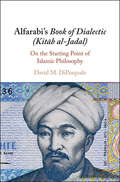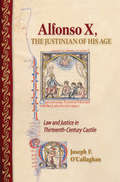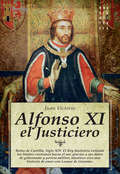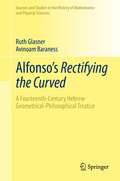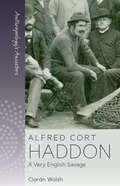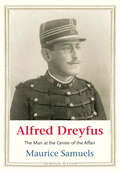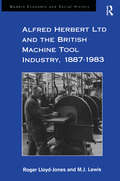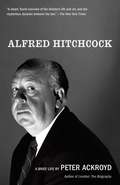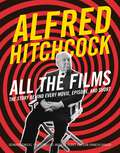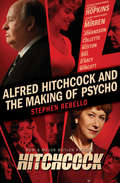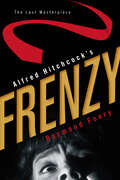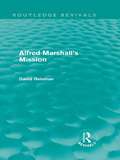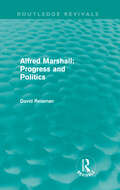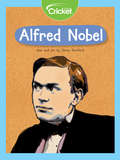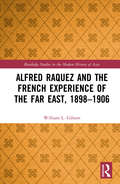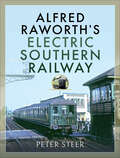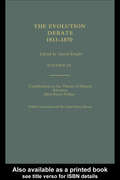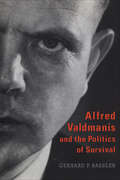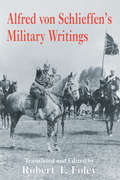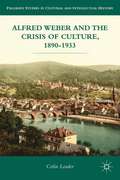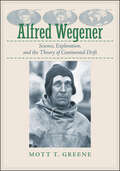- Table View
- List View
Alexis in America: A Russian Grand Duke's Tour, 1871-1872
by Lee A. FarrowIn the autumn of 1871, Alexis Romanov, the fourth son of Tsar Alexander II of Russia, set sail from his homeland for an extended journey through the United States and Canada. A major milestone in U.S.-Russia relations, the tour also served Duke Alexis's family by helping to extricate him from an unsuitable romantic entanglement with the daughter of a poet. Alexis in America recounts the duke's progress through the major American cities, detailing his meetings with celebrated figures such as Samuel Morse and Henry Wadsworth Longfellow and describing the national self-reflection that his presence spurred in the American people. The first Russian royal ever to visit the United States, Alexis received a tour through post-Civil War America that emphasized the nation's cultural unity. While the enthusiastic American media breathlessly reported every detail of his itinerary and entourage, Alexis visited Niagara Falls, participated in a bison hunt with Buffalo Bill Cody, and attended the Krewe of Rex's first Mardi Gras parade in New Orleans. As word of the royal visitor spread, the public flocked to train depots and events across the nation to catch a glimpse of the grand duke. Some speculated that Russia and America were considering a formal alliance, while others surmised that he had come to the United States to find a bride. The tour was not without incident: many city officials balked at spending public funds on Alexis's reception, and there were rumors of an assassination plot by Polish nationals in New York City. More broadly, the visit highlighted problems on the national level, such as political corruption and persistent racism, as well as the emerging cultural and political power of ethnic minorities and the continuing sectionalism between the North and the South. Lee Farrow joins her examination of these cultural underpinnings to a lively narrative of the grand duke's tour, creating an engaging record of a unique moment in international relations.
Alfarabi's Book of Dialectic (Kitāb al-Jadal): On the Starting Point of Islamic Philosophy
by David M. DiPasqualeWidely regarded as the founder of the Islamic philosophical tradition, and as the single greatest philosophical authority after Aristotle by his successors in the medieval Islamic, Jewish, and Christian communities, Alfarabi was a leading figure in the fields of Aristotelian logic and Platonic political science. The first complete English translation of his commentary on Aristotle's Topics, Alfarabi's Book of Dialectic, or Kitāb al-Jadal, is presented here in a deeply researched edition based on the most complete Arabic manuscript sources. David M. DiPasquale argues that Alfarabi's understanding of the Socratic art of dialectic is the key prism through which to grasp his recovery of an authentic tradition of Greek science on the verge of extinction. He also suggests that the Book of Dialectic is unique to the extent to which it unites Alfarabi's logical and political writings, opening up novel ways of interpreting Alfarabi's influence.
Alfie's War: A Fleet Air Arm Pilot's Exciting Exploits on HMH Illustrious, and Greece and Crete
by Richard PikeThe bestselling author of Seven Seas, Nine Lives continues the remarkable experiences of Captain A.W.F. &“Alfie&” Sutton during the Second World War. Written in three parts, this book follows the harrowing adventures of Captain A.W.F. &“Alfie&” Sutton, CBE, DSC and bar, RN. During events which come as close to fiction as is imaginable, the first part describes how Alfie, badly injured and close to death during the bombing of HMS Illustrious by the Luftwaffe in January 1941, wakes to find himself laid out among the dead, but miraculously still able to help the ship on to Malta. After full recovery, part two starts with his involvement in the Allied campaign in Greece in the spring of 1941, leading to him eventually evacuating the Greek royal family in a flying boat. After numerous escapades he fights with the defenders during the German invasion of Crete in 1941. Admiral Cunningham was later to describe Sutton&’s efforts as &“an example of grand personal courage under the worst possible conditions which stands out brightly in the gloom.&” It was a struggle doomed to failure, but Alfie survived to continue his war and tell his story to author Richard Pike who relates it here with passion, pace and drama.
Alfonso X, the Justinian of His Age: Law and Justice in Thirteenth-Century Castile
by Joseph F. O'CallaghanIn this magisterial work, Joseph O'Callaghan offers a detailed account of the establishment of Alfonso X's legal code, the Libro de las leyes or Siete Partidas, and its applications in the daily life of thirteenth-century Iberia, both within and far beyond the royal courts. O'Callaghan argues that Alfonso X, el Sabio (the Wise), was the Justinian of his age, one of the truly great legal minds of human history.Alfonso X, the Justinian of His Age highlights the struggles the king faced in creating a new, coherent, inclusive, and all-embracing body of law during his reign, O'Callaghan also considers Alfonso X's own understanding of his role as king, lawgiver, and defender of the faith in order to evaluate the impact of his achievement on the administration of justice. Indeed, such was the power and authority of the Alfonsine code that it proved the king's downfall when his son invoked it to challenge his rule. Throughout this soaring legal and historical biography, O'Callaghan reminds us of the long-term impacts of Alfonso X's legal works, not just on Castilian (and later, Iberian) life, but on the administration of justice across the world.
Alfonso XI, el Justiciero (Historia Incógnita)
by Juan VictorioEn 1312 muere Fernando IV y la corona pasa a su hijo Alfonso XI que tiene apenas un año de edad. Mientras crece, Castilla conoce una de las etapas más negras de su historia debido a la rapacidad de la alta nobleza, que se había encargado de su tutoría.
Alfonso's Rectifying the Curved: A Fourteenth-Century Hebrew Geometrical-Philosophical Treatise (Sources and Studies in the History of Mathematics and Physical Sciences)
by Ruth Glasner Avinoam BaranessThis volume offers a new English translation, introduction, and detailed commentary on Sefer Meyasher 'Aqov, (The Rectifying of the Curved), a 14th-century Hebrew treatise on the foundation of geometry. The book is a mixture of two genres: philosophical discussion and formal, Euclidean-type geometrical writing. A central issue is the use of motion and superposition in geometry, which is analyzed in depth through dialog with earlier Arab mathematicians. The author, Alfonso, was identified by Gita Gluskina (the editor of the 1983 Russian edition) as Alfonso of Valladolid, the converted Jew Abner of Burgos. Alfonso lived in Castile, rather far from the leading cultural centers of his time, but nonetheless at the crossroad of three cultures. He was raised in the Jewish tradition and like many Sephardic Jewish intellectuals was versed in Greek-Arabic philosophy and science. He also had connections with some Christian nobles and towards the end of his life converted to Christianity. Driven by his ambition to solve the problem of the quadrature of the circle, as well as other open geometrical problems, Alfonso acquired surprisingly wide knowledge and became familiar with several episodes in Greek and Arabic geometry that historians usually consider not to have been known in the West in the fourteenth century. Sefer Meyasher 'Aqov reflects his wide and deep erudition in mathematics and philosophy, and provides new evidence on cultural transmission around the Mediterranean.
Alfred Cort Haddon: A Very English Savage (Anthropology's Ancestors #5)
by Ciarán WalshAn innovative account of one of the least-understood characters in the history of anthropology. Using previously overlooked, primary sources Ciarán Walsh argues that Haddon, the grandson of anti-slavery activists, set out to revolutionize anthropology in the 1890s in association with a network of anarcho-utopian activists and philosophers. He regards most of what has been written about Haddon in the past as a form of disciplinary folklore shaped by a theory of scientific revolutions. The main action takes place in Ireland, where Haddon adopted the persona of a very English savage in a new form of performed photo-ethnography that constituted a singularly modernist achievement in anthropology. From the Introduction: Alfred Cort Haddon was written out of the story of anthropology for the same reasons that make him interesting today. He was passionately committed to the protection of simpler societies and their civilisations from colonists and their supporters in parliament and the armed forces.
Alfred Dreyfus: The Man at the Center of the Affair (Jewish Lives)
by Maurice SamuelsAn insightful new biography of the central figure in the Dreyfus Affair, focused on the man himself and based on newly accessible documents On January 5, 1895, Captain Alfred Dreyfus&’s cries of innocence were drowned out by a mob shouting &“Death to Judas!&” In this book, Maurice Samuels gives readers new insight into Dreyfus himself—the man at the center of the affair. He tells the story of Dreyfus&’s early life in Paris, his promising career as a French officer, the false accusation leading to his imprisonment on Devil&’s Island, the fight to prove his innocence that divided the French nation, and his life of quiet obscurity after World War I. Samuels&’s striking perspective is enriched by a newly available archive of more than three thousand documents and objects donated by the Dreyfus family. Unlike many historians, Samuels argues that Dreyfus was not an &“assimilated&” Jew. Rather, he epitomized a new model of Jewish identity made possible by the French Revolution, when France became the first European nation to grant Jews full legal equality. This book analyzes Dreyfus&’s complex relationship to Judaism and to antisemitism over the course of his life—a story that, as global antisemitism rises, echoes still. It also shows the profound effect of the Dreyfus Affair on the lives of Jews around the world.
Alfred Herbert Ltd and the British Machine Tool Industry, 1887-1983 (Modern Economic and Social History)
by Roger Lloyd-Jones M.J. LewisAt the beginning of the twentieth century Britain was amongst the world leaders in the production of machine tools, yet by the 1980s the industry was in terminal decline. Focusing on the example of Britain's largest machine tool maker, Alfred Herbert Ltd of Coventry, this study charts the wider fortunes of this vital part of the manufacturing sector. Taking a chronological approach, the book explores how during the late nineteenth century the industry developed a reputation for excellence throughout the world, before the challenges of two world wars necessitated drastic changes and reorganisations. Despite meeting these challenges and emerging with confidence into the post-war market place, the British machine tool industry never regained its pre-eminent position, and increasingly lost ground to foreign competition. By using the example of Alfred Herbert Ltd to illuminate the broader economic and business history of the British machine tool industry, this study not only provides a valuable insight into British manufacturing, but also contributes to the ongoing debates surrounding Britain's alleged decline as a manufacturing nation.
Alfred Hitchcock
by Peter AckroydA gripping short biography of the extraordinary Alfred Hitchock, the master of suspense. Alfred Hitchcock was a strange child. Fat, lonely, burning with fear and ambition, his childhood was an isolated one, scented with fish from his father's shop. Afraid to leave his bedroom, he would plan great voyages, using railway timetables to plot an exact imaginary route across Europe. So how did this fearful figure become the one of the most respected film directors of the twentieth century? As an adult, Hitch rigorously controlled the press's portrait of him, drawing certain carefully selected childhood anecdotes into full focus and blurring all others out. In this quick-witted portrait, Ackroyd reveals something more: a lugubriously jolly man fond of practical jokes, who smashes a once-used tea cup every morning to remind himself of the frailty of life. Iconic film stars make cameo appearances, just as Hitch did in his own films: Grace Kelly, Cary Grant, and James Stewart despair of his detached directing style and, perhaps most famously of all, Tippi Hedren endures cuts and bruises from a real-life fearsome flock of birds. Alfred Hitchcock wrests the director's chair back from the master of control and discovers what lurks just out of sight, in the corner of the shot.
Alfred Hitchcock All the Films: The Story Behind Every Movie, Episode, and Short
by Bernard Benoliel Gilles Esposito Murielle Joudet Jean-François RaugerOrganized chronologically and covering every short film, television episode, and classic film that the "Master of Suspense" directed over the course of his illustrious, 60-year career, Alfred Hitchcock All the Films draws upon years of research to tell the behind the scenes stories of how each project was conceived, cast, and produced, down to the creation of the costumes, the search for perfect locations, and of course, the direction of some of cinema's most memorable scenes. Spanning more than six decades, and including stories of work with longtime collaborators like costume designer Edith Head, title designer Saul Bass, and composer Bernard Herrmann, this book details the creative processes that resulted in numerous classic films like Vertigo,The Birds,Psycho, Rear Window, North By Northwest,andTo Catch a Thief (to name a few). The director's classic TV series are also covered extensively along with original release dates, lesser-known short films, box office totals, surreptitious casting details, and other insider scoops that will keep fans and students alike turning pages. Alfred Hitchcock All the Films is the perfect book for the movie fan in your life.
Alfred Hitchcock and the Making of Psycho
by Stephen RebelloA &“meticulous history&” of the classic suspense film based on exclusive interviews with the director, writers, cast, and crew (The New York Times Book Review).First released in June 1960, Psycho altered the landscape of horror films forever. But just as compelling as the movie itself is the story behind it, which has been adapted as a movie starring Anthony Hopkins as Hitchcock, Helen Mirren as his wife Alma Reville, and Scarlett Johansson as Janet Leigh. Stephen Rebello brings to life the creation of one of Hollywood&’s most iconic films, from the story of Wisconsin murderer Ed Gein, the real-life inspiration for the character of Norman Bates, to Hitchcock&’s groundbreaking achievements in cinematography, sound, editing, and promotion. Packed with captivating insights from the film&’s stars, writers, and crewmembers, Alfred Hitchcock and the Making of Psycho is a riveting and definitive history of a signature Hitchcock cinematic masterpiece.
Alfred Hitchcock's Frenzy: The Last Masterpiece
by Raymond FoeryAfter an unparalleled string of artistic and commercial triumphs in the 1950s and 1960s, Alfred Hitchcock hit a career lull with the disappointing Torn Curtain and the disastrous Topaz. In 1971, the depressed director traveled to London, the city he had left in 1939 to make his reputation in Hollywood. The film he came to shoot there would mark a return to the style for which he had become known and would restore him to international acclaim. Like The 39 Steps, Saboteur, and North by Northwest before, Frenzy repeated the classic Hitchcock trope of a man on the run from the police while chasing down the real criminal. But unlike those previous works, Frenzy also featured some elements that were new to the master of suspense’s films, including explicit nudity, depraved behavior, and a brutal act that would challenge Psycho’s shower scene for the most disturbing depiction of violence in a Hitchcock film. In Alfred Hitchcock’s Frenzy: The Last Masterpiece, Raymond Foery recounts the history—writing, preprod
Alfred Marshall's Mission (Routledge Revivals)
by David ReismanAlfred Marshall was anxious to do good. Intended by an Evangelical father for the vocation of clergyman, the author of the mould-shaping Principles of Economics remained to the end of his days a great preacher deeply committed to raising the tone of life. First published in 1990, Alfred Marshall’s Mission explains how this most moral of political economists sought to blend the downward sloping utility function of Jevons and Menger with the organic evolutionism of Darwin and Spencer, how this celebrated theorist of social alongside economic growth sought to combine the mathematical marginalism of Cournot. Thunen and Edgeworth with the ethical uplift of Green, Jowett and Toynbee. The conclusion reached is that perhaps Marshall was, after all, too anxious to do good. Far more economists, however, have been not anxious enough; and that in itself gives this study of Marshall’s life and times a present day relevance which would, no doubt, have appealed strongly to the shy Cambridge professor who is its subject.
Alfred Marshall: Progress And Politics (Routledge Revivals)
by David ReismanFirst published in 1987, Alfred Marshall: Progress and Politics provides an enlightening insight into Marshall's thoughts on social improvement, adaptive upgrading, policy and polity. He planned books on these subjects which he never subsequently wrote, but the thesis of this work is that a close study of such writings as Marshall did complete makes possible a very detailed reconstruction of the important contribution which Marshall was capable of making to Victorian evolutionary thought (much in the shadow of Darwin and Spencer). In the ongoing debate on the political element in political economy, he reveals himself to have been as much an eclectic as was Adam Smith and as much a man of commitment as was T. H. Green.
Alfred Nobel
by James RumfordDid you know the Nobel Prize is named after the man who invented dynamite? Learn all about the life of Alfred Nobel, who grew up in a desperately poor family.
Alfred Nobel: The Man Behind the Peace Prize
by Kathy-Jo WarginAlfred Nobel was the man who founded what became known as The Nobel Prizes. Nobel also invented dynamite, becoming very wealthy from his invention. Saddened by its use for harmful destruction, Nobel left his fortune to create yearly prizes for those who have rendered the greatest services to mankind.
Alfred Raquez and the French Experience of the Far East, 1898-1906 (Routledge Studies in the Modern History of Asia)
by William L. GibsonA Study of an Enigmatic Travel Writer and His Work in Colonial Asia during the fin de siècle. In 1898, a man calling himself Alfred Raquez appeared in Indochina claiming to be a writer travelling the world to escape unfathomable sorrows back home in France. He published thousands of pages of highly detailed travel accounts that open a unique window onto the European presence in the Far East. He travelled far into the Zomia of upland Southeast Asia, a peripheral zone populated by people who lived beyond official state power. Raquez explored the nightlife of Shanghai and operated a popular cabaret in Hanoi. An amateur anthropologist, he helped mount expositions of colonial material in Hanoi and Marseille. Raquez met people in the highest circles of belle époque Indochina, as well as the kings of Annam, Cambodia, Laos and Siam. And yet, despite the charm and the ebullience and the erudition, through all his travels and rising fame, the man kept a secret that was so mortifying that even his closest companions would not learn of it until after his death in 1907. In truth, Alfred Raquez did not exist. A fascinating read for students and scholars of colonial Southeast Asia, and European colonialism more broadly.
Alfred Raworth's Electric Southern Railway
by Peter SteerThe Southern Railway between 1923 and 1939 was the only British company to carry out a sustained programme of electrification which became known as the Southern Electric. Unlike many recent projects, each incremental step was completed on time and within budget. This successful project was more impressive as it was achieved during a period of economic stagnation (including the ‘great depression’) and despite government disapproval of the method of electrification. The driving force behind this endeavor was the railway’s general manager, Sir Herbert Walker, but at his side was his electrical engineer, Alfred Raworth, the man one journalist described as an ‘electrification genius’. Alfred Raworth’s career began working with his father the eminent consulting engineer and entrepreneur, John Smith Raworth. Following the collapse of his father’s business Alfred joined the railway industry and devised an ambitious and innovative electrification design. This was discarded when the railways of southern England were ‘grouped’ into the Southern Railway after which he took responsibility for the implementation of the electrification schemes. With Walker’s retirement in 1937, those who continued to support steam traction took the policy lead. A marginalised Raworth retired but was later to witness the fruition of many of his discarded ideas.
Alfred Russell Wallace Contributions to the theory of Natural Selection, 1870, and Charles Darwin and Alfred Wallace , 'On the Tendency of Species to form Varieties' (The\evolution Debate, 1813-1870 Ser.)
by Charles Darwin Alfred Russel Wallace David KnightWallace noticed on expeditions to the Amazon and the Malay archipelego that mammals in Southeast Asia are more advanced than their Australian cousins. His suggestion was that the two continents had split before the better adapted mammals had evolved in Asia. The isolated Australian marsupials were able to thrive, whilst those in Asia were driven to extinction by competition from more advanced mammals. This led to his theory of natural selection, which he presented to the Linnean Society in 1858 with Charles Darwin. This volume reprints those papers presented to the Linnean Society.
Alfred Tarski on Scientific Semantics (Logic, Epistemology, and the Unity of Science #62)
by David Hitchcock Magda StroińskaThis book tells the story of the landmark event in modern logic whereby Alfred Tarski became “the man who defined truth”. Alfred Tarski’s classic monograph on truth became known internationally in 1935, when he presented its ideas in German at an international conference and collaborated in preparation of its German translation. This book provides the first English translation of the Polish version of Tarski’s conference paper, which for purposes of comparison is printed side-by-side with a new exact English translation of the German version. It offers for the first time a comprehensive and detailed analysis of the paper, and for the first time a description and analysis of the discussion of the paper immediately after its presentation. It discusses 22 substantive differences between the two versions. The book also extracts from recently discovered correspondence about the German translation of the truth monograph how it was decided to produce such a translation, the process of vetting and changing the translation, changes requested by Tarski, objections to the appeal to intuition in the Polish original (supported by a list of those appeals with their replacements in the German and English translations), other translational issues, discrepancies other than those concerning appeals to intuition between the Polish original and its German translation, the “Keystone cops” saga of Tarski’s off-prints, and monetary matters. It lists from Tarski’s journal his skiing, mountaineering and tourist trips in 1935, and describes his companions on those trips. An electronic supplement translates or summarizes the complete correspondence, with comments, and includes images from Tarski’s journal of his itineraries of his 1935 trips, with the editors' explanatory comments.
Alfred Valdmanis and the Politics of Survival
by Gerhard P. BasslerAlfred Valdmanis is best known in Canada for his infamous role in Premier Joey Smallwood's scheme to industrialize Newfoundland. A Latvian immigrant, he was appointed Director General of Economic Development in 1950 with the understanding that through his connections to Europe he could entice German and Baltic industrialists to the isolated, rural island. His influence was brought to an abrupt end when, in 1954, he was charged with defrauding the government. The media, latching on to his murky past and his possible affiliation with war criminals, made him the scapegoat of Newfoundland's problems, painting him as part comedian, part sinister villain. This was not the first time his name was connected with controversial issues. Valdmanis's wily political manoeuvring is more the stuff of fiction than history. Between 1938, at age 29, and his ironic downfall in the safe haven of Canada, he was a finance minister of pre-war Latvia, a government official during the Soviet invasion, a shrewd collaborator under the Nazi occupation, then, a friend to the Allies, a spokesman for Latvian POW and displaced persons, and an adviser to the government of Canada. In this first serious biography of Alfred Valdamis historian Gerhard Bassler casts the story of this political manipulator and chameleon in new terms: the often tragic consequences of the will to survive.
Alfred Von Schlieffen's Military Writings (Military History and Policy)
by Robert T. FoleyA collection of some of the writings of Generalfeldmarschall Alfred Graf von Schlieffen, one of the more intriguing of Imperial Germany's military figures. Schlieffens 15 years as Chief of the General staff left a stamp upon both military and political institutions of Wilhelmine Germany.
Alfred Weber and the Crisis of Culture, 1890–1933
by Colin LoaderAlfred Weber was an important participant in the dialogue over the political and cultural crises of the late Empire and Weimar Republic. This study connects Weber's career to the social, political, intellectual, cultural, and institutional contexts of the period.
Alfred Wegener: Science, Exploration, and the Theory of Continental Drift
by Mott T. GreeneA masterful biography of Alfred Wegener (1880–1930), the German scientist who discovered continental drift.Winner of the CHOICE Outstanding Academic Title of the Choice ACRLAlfred Wegener aimed to create a revolution in science which would rank with those of Nicolaus Copernicus and Charles Darwin. After completing his doctoral studies in astronomy at the University of Berlin, Wegener found himself drawn not to observatory science but to rugged fieldwork, which allowed him to cross into a variety of disciplines. The author of the theory of continental drift—the direct ancestor of the modern theory of plate tectonics and one of the key scientific concepts of the past century—Wegener also made major contributions to geology, geophysics, astronomy, geodesy, atmospheric physics, meteorology, and glaciology. Remarkably, he completed this pathbreaking work while grappling variously with financial difficulty, war, economic depression, scientific isolation, illness, and injury. He ultimately died of overexertion on a journey to probe the Greenland icecap and calculate its rate of drift. This landmark biography—the only complete account of the scientist’s fascinating life and work—is the culmination of more than twenty years of intensive research. In Alfred Wegener, Mott T. Greene places Wegener’s upbringing and theoretical advances in earth science in the context of his brilliantly eclectic career, bringing Wegener to life by analyzing his published scientific work, delving into all of his surviving letters and journals, and tracing both his passionate commitment to science and his thrilling experiences as a polar explorer, a military officer during World War I, and a world-record–setting balloonist. In the course of writing this book, Greene traveled to every place that Alfred Wegener lived and worked—to Berlin, rural Brandenburg, Marburg, Hamburg, and Heidelberg in Germany; to Innsbruck and Graz in Austria; and onto the Greenland icecap. He also pored over archives in Copenhagen, Munich, Marburg, Graz, and Bremerhaven, where the majority of Wegener’s surviving papers are found. Written with great immediacy and descriptive power, Alfred Wegener is a powerful portrait of the scientist who pioneered the modern concept of unified Earth science. The book should be of interest not only to earth scientists, students of polar travel and exploration, and historians but to all readers who are fascinated by the great minds of science.

